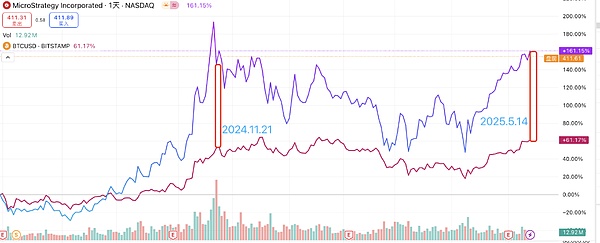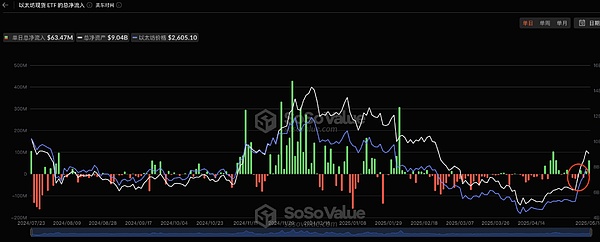On November 24, 2024, Citron Research, a well-known short-selling institution, stated on social media that although it is optimistic about Bitcoin in the long term, it believes that the stock price of MicroStrategy (MSTR) has deviated from the fundamentals of Bitcoin. Therefore, they adopted a hedging strategy of shorting MSTR and going long on BTC, betting that the trends of the two will eventually converge. However, data six months later showed that the price difference between MSTR and BTC not only did not narrow, but expanded by 7%. This means that if Citron's strategy is strictly implemented, the hedging positions have incurred substantial losses in the past six months.

Why is the premium rate of MSTR's Bitcoin assets as high as 103%? Although the market generally believes that this phenomenon stems from its leverage strategy of "issuing bonds to buy coins", as of May 12, 2025, MSTR has held nearly $60 billion in Bitcoin, while its total liabilities are only $8.5 billion, and its actual debt ratio is less than 15%. This financial structure shows that traditional leverage theory cannot fully explain its high premium phenomenon. In fact, MSTR's extremely high asset premium rate reflects the market's reconstruction of its valuation of its "Bitcoin bank" business model - strategic first-mover advantage and super profit expectations.
For example, in securities trading, there is a significant stratification effect in market liquidity: when investors buy a small amount of individual stocks, the transaction price is usually close to the market price; however, if they try to acquire more than 5% of the shares, the stock price may rise sharply due to insufficient order book depth. This additional cost caused by large transactions is called liquidity premium. According to Coinglass, there are only 2.17 million coins left in the entire centralized exchange, and the cost of replicating one MSTR (568,840 coins) will far exceed US$60 billion.
The liquidity premium essentially reflects the market's expectation difference on the future price of Bitcoin. The increase in the premium rate reflects the further strengthening of the market's bullish sentiment. From April 7 to May 12, 2025, MSTR's Bitcoin asset premium rate quickly climbed from 55% to 103%. This change shows that: 1. The market's valuation expectations for Bitcoin are being systematically revised upward. 2. The liquidity of the selling orders in the spot market is structurally tense (only 2.17 million coins are left in the exchange balance) line="tROG" style="text-align: left;">Based on these analyses, we remain optimistic that Bitcoin will continue to hit new highs this year.
From May 7 to May 9, the price of ETH soared from $1,760 to $2,490, an increase of 40%. However, strangely, the Ethereum ETF not only had no inflows but also outflowed $20 million during the same period. This divergence shows that the main driving force of this round of market comes from retail investors, not institutions. The sharp rise + retail dominance has also caused the market to have great concerns about the sustainability of this round of market.

In fact, this situation is not unique to the encryption market. According to a report by JPMorgan Chase, on April 3, the S&P plunged 5%, but retail investors made a record net purchase of 4.5 billion stocks and ETFs, with net purchases reaching 50 billion US dollars in the first week of April alone. In the earlier January-March 2025, retail investors had already made a net purchase of 67 billion US dollars in stocks and ETFs. From the historical data, although the trend of institutional holdings is indeed more indicative, institutions often make mistakes.
During the outbreak of the new crown epidemic in March 2020, institutional investors caused four circuit breakers in the US stock market due to panic selling, but they aggressively covered their positions by chasing highs after the sharp rise in April, missing the fastest bear market rebound in history (very similar to the current situation). Ironically, according to Goldman Sachs prime brokerage data, hedge funds’ net selling reached an annual peak on March 23, 2020, the day the market bottomed out, while retail investors set a single-day account opening record through platforms such as Robinhood.The same is true in the crypto market. From December 5, 2024 to February 4, 2025, when ETH peaked and fell, ETH ETFs accumulated a net inflow of $3.2 billion, but as ETH entered a new round of decline, institutions that were bottom-fishing sold all of their ETH ETFs. Interestingly, after the institutions sold their shares, the market began to bottom out and rebound.Therefore, in many cases, institutions will also make the mistake of chasing ups and downs.
On May 14, ETH fell by 2.6%, but the ETH ETF received an inflow of $63 million against the trend. It seems that some institutions that missed out on the opportunity began to cover their positions during the price correction. If the net inflow of ETH ETF funds further expands in the next 2-3 days, then the institutional "admission wave" may begin from then on.
Although the logic supporting the reversal of ETH's trend is still weak, the improvement in fundamentals and funding brought about by the Pectra upgrade can at least support Ethereum to return to the valuation center of 2800-3200. Therefore, investors with a cost below 2800 will definitely not be trapped in the medium and long term.
 Jixu
Jixu
 Jixu
Jixu Hui Xin
Hui Xin Joy
Joy Jasper
Jasper Jasper
Jasper Catherine
Catherine Catherine
Catherine Jasper
Jasper Hui Xin
Hui Xin Alex
Alex